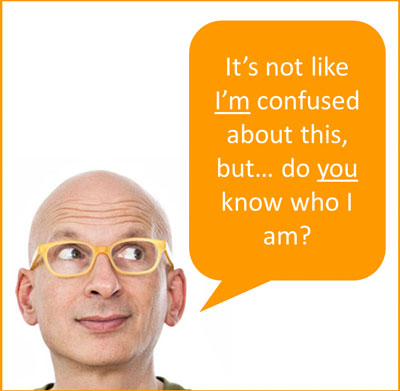
Seth Godin doesn’t use images in his blog posts and he’s got only a few on his website… a couple of him and the rest of his book covers.
Does that mean you should do the same?
No, and there are a lot of reasons why I think so.
They all hinge on the most obvious thing — you aren’t Seth Godin.
First, he’s famous. So famous that he doesn’t need to put a lot of pictures of himself on his website to help you Know, Like and Trust him.
He writes a blog post every day, and he’s been writing his current blog since 2002. (When did you say you graduated from your training?)
He’s got 18 worldwide bestsellers that have been translated into 35 languages.
Would you be happy to have 5,000 subscribers? That’s about how many people subscribe and unsubscribe from his blog every day!
If you know who he is, and you subscribe to his blog, images are not drawing you to or into his posts. They’re short. Let’s face it — if you can’t stick it for the 41 words he published on March 31, 2015, a picture isn’t going to make any difference.
He’s got the “Know-Like-Trust Factor” covered and with a subscriber base in the multiple 6-figure zone, I’m sure he doesn’t care whether or not any one person reads to the end of his post.
Where does that leave you?
The research shows that for those of us who don’t enjoy the immense readership Seth Godin has, images are really important. We’re going to focus on 4 statistics that are meaningful to hands-on practitioners and movement educators who use their websites and blogs to attract clients.
Relevant images get more eyes on your post

This means that when you have images on your website or your blog post that are related to what you’re writing about, you are likely to get more people looking at those pages than if you leave images out of your thinking.
It also means that once people click onto your page, they’re more likely to stay if you have images. That helps you in search rankings because people don’t bounce in and out in the same breath.
(When people land on your site and leave right away, it’s called a “bounce” and your bounce rate is tracked by the search engines. When people land and leave quickly, the search engine take it as a sign that people don’t find what they’re looking for on your site so they lower your site in their rankings.)
What about pictures of cute kitties, flowers, and beautiful dreamy photos that evoke nice feelings? If they don’t have anything to do with what you’re talking about — at best, they aren’t going to help you.

See what I mean?
This is a very cute kitten… I mean, come on — it’s sitting in the sunshine in a little bowl. But aside from the fact that it actually does illustrate my point that it’s not the right photo for this post, it has nothing to do with what we’re talking about.
Would it make you keep reading? Not likely.
Would it lower my credibility if I weren’t using it to make a point? Very likely.
The problem is that when people are confused, they tend to make that be their impression of you. If your images don’t make sense to them, they figure what you write isn’t reliable.
So a photo like this might attract attention on a Facebook post if it were your kitten… or if you had a quote that made people think. But in an article where it doesn’t make sense, it’s likely to hurt you.
Your brain understands pictures faster than words.

60,000 times faster is a LOT…
If it took all of one second to understand a picture, it would take 3.6 hours to understand the words that explained it.
If you have great graphics, you don’t need many as words as you need without them.
People don’t have a lot of time to waste on your site. Mine, either, for that matter. When you give them something worthwhile quickly, you respect their time and they’re more likely to come back.
If not, they’ll be on somebody else’s site trying to find what they’re looking for.
A picture is worth a thousand words

I know. It’s an old saw. But the reason it’s still around so long is that it’s true.
How much time is involved in writing and reading what you can get in one glance at that pie chart?
Not only that — words don’t give you the emotional kick you might be getting from the graphic.
People love to share images

Everybody hopes their posts will “go viral.”
There’s no reliable, proven “Formula For Going Viral,” but there has been research into why people hit the “share” button on social media.
People most often share things that make them feel good about themselves because they shared. So when you give them something that’s meaningful in its own right and also gives them their friends will value, they are more likely to pass it on.
[Tweet “When people share what you post, it’s like making a referral to you. “]
This is just what you want as a hands-on practitioner or movement educator — because many people who find you need time to develop a relationship with you before they get in touch. Checking out your posts because they were recommended by a friend fast-tracks that process.
Images are your friends… choose them wisely, and let them help you!
~~
If this post made you think about your practice, subscribe! You’ll get information on a variety of practice-building topics — and please share this resource with other practitioners, because when you know how to find them, there are enough clients for everyone!

